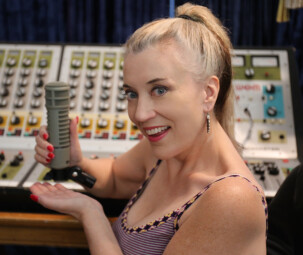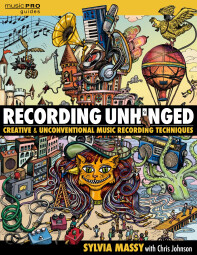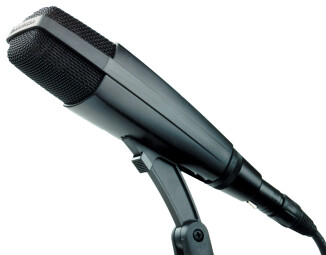Prince, Tom Petty, System of a Down, Tool, Red Hot Chili Peppers and Sevendust are just some of the artists on producer and engineer Sylvia Massy’s discography. The 30-year studio veteran has never been bound by convention, and often finds solutions that deviate from standard studio wisdom. Her new book, “Recording Unhinged” (Hal Leonard), describes many of her non-standard techniques, as well as those from studio legends like Bob Clearmountain, Geoff Emerick, Jack Joseph Puig, Al Schmitt, Susan Rogers and many others.
Audiofanzine had the opportunity to speak with her about Recording Unhinged and some of the unconventional techniques it offers up. In addition we talked shop about recording, mixing and gear.
The book is really impressive. Not only did you write it but you also illustrated it, including the very colorful cover. Why did you decide to do the book in the first place?

The book came out of just having all these weird things that I would do that other people wouldn’t do, and I noticed that when I went into sessions, I was building interesting things, so I thought I’d share that. And then talking to different engineers that I’m associated with at the National Academy of Recording Arts and Sciences, and at trade shows, I realized that they also had some interesting techniques that nobody had really documented. And there were about 35 different people that I interviewed, and I collected their stories and some of their techniques. And then I illustrated some of their techniques, because I’m better at drawing it out than trying to explain it. It’s much easier for me. And that turned into doing much larger illustrations and caricatures of these people that I was interviewing. So I just went on with it. And with the help of Chris, my manager, and the co-writer of the book, we created all of these different panels. The Producer Pods and Engineering Marvels and the people in the industry that are heroes.
The book is kind of modular. Little short pieces all organized by type of instrument to record or type of recording technique.
It’s like tapas. You’re going to take a little bit of this and a little bit of that and put it on a plate and enjoy it.
It makes it really easy to read because you can just jump into any chapter, grab a few things, go somewhere else, etc.
And that’s what I was hoping, that it would become a coffee-table type book, where you could open up one page and get inspired. Especially if it was just on the corner of your console or on top of a speaker. Then you just open a page and it should help unstick you.
The book offers lots of unique ways to get results in the studio. For example, I love the part about distracting singers.
It’s something that I’m really good at. I worked on my techniques over the years on how to get a great performance, and a lot of it has to do with distracting the musician or the singer so that they stop thinking about themselves. You can be really goofy in the studio. You can adjust the temperature to get an effect. If you want the singer to be angry, because you have an aggressive part, then you make it uncomfortable for them. Or, I read something about John Lennon hanging upside down once, and I thought I’d try that. It was a disaster, actually, I wouldn’t do it again. The poor guy almost had an aneurism. That was actually Serj Tankian, the singer from System of a Down .

You had more success with Serj when you set up a tent in the studio for him to use as a vocal booth.
That worked out, really well. If you’re in a studio where you don’t have an isolation booth, and there’s too much reflection from the walls coming back into your vocal mic, a tent works great.
So the tent was there for sonic reasons, but it also gave him give him his own space to be in while singing?
The initial reason was to calm down the reflections. But it turned into his special place, and was even better.
Was it a canvas tent?
It was just a regular camping tent. It was tall enough that you could stand up in it and you could stand up a mic in it. And also, it didn’t require stakes, because we were in someone’s house — Rick Rubin’s basement, actually.
There was a great quote in the book, I don’t remember who said it, but the gist was that rules are just suggestions and whatever you do is right, as long as it works. [Laughs]
Yeah, and if it doesn’t work, you can chalk it up to experience.
You wrote that you’re able to know — with confidence — when a mix is finished.
Everyone has their own point in a mix when they know it’s finished. For me, I actually do a little cheating. I make sure that my mix kicks ass on some popular commercial finished album that maybe I admire.
So you A/B?
I A/B. And they’re [the comparison songs] usually finished and mastered, so I’ll do premastering, to make it compare, so it jumps out of the speakers. A lot of times, if a mix has been labored on for several days, start over, because you’ve gone too far. The fresh pushing up the faders, the initial instinct of where things should sit in a mix is often better than working on it, working on it and working on it.
Do you have a routine when mixing where you stop at a certain point and listen the next day, or anything like that?
I do pace myself out of necessity. If you do it for 30 years, you know when you burn out and your ears are going to fail. I do like to leave it up overnight. Maybe finish at 10PM, and come in at noon the next day.
It’s amazing what you hear the next day, what you didn’t notice at the time.
It’s true. And headphones are very revealing, too. If you get a chance to double check your work with headphones, you’ll hear all those edits that you didn’t put fades on. And those little ticks from your mouth in the breaths of a vocal. You really need to check things with headphones.
What’s your basic workflow when you’re mixing. Do you bring everything up to start, or one thing at a time?
If I recorded the material myself, I’ll just start with the drums because I’ll know how it’s going to shape. But if I’m working on someone else’s recording, I’ll push everything up, and try to get an initial shape, and then mute everything and work only on one thing at a time. And then slowly build it back up again.
There was a section in your book about LCR mixing. That’s a cool technique, though it doesn’t work for everything. Do you do that a lot?
I do. I try to do that all the time. It’s simple with the Neve that I have, because this 1972 8038 doesn’t have a lot of [panning] choices. But Rick Rubin made it ok to have a left-center-right mix. And in fact, that’s all he would do for the Tom Petty stuff. If you listen to some of the great Tom Petty records that he worked on, a lot of those mixes are stacked left-center-right. The biggest challenge is to be able to separate layers of guitars when they’re on top of each other.
You do it with EQ?
With EQ or compression.
And the vocal is right out there in the middle.

Right. It gives you a lot of room for that center material which is the vocal.
It seems to me that having such hard panning makes it more dramatic.
It does. And the other great thing about left-center-right is that it’s a broad spectrum, and you have to work harder on the individual parts that you’re recording to make sure that they work together.
Would you ever do a mix like that and then cheat something in between?
Of course. It’s nice when you have a pan pot.
So you work on your Neve console, but I assume you use automation out of Pro Tools on it? How have you changed your workflow since the advent of digital?
Now I’m working hybrid, so I do submixing in the box. And then I bring up stems, basically, on the console. But I do finish with Flying Faders automation — physical Flying Faders automation. It’s just really fast for me.
You started in recording when all the effects and compressors and other processors were outboard. Do you now use a lot of plug-ins, or do you still like to use the hardware?
I love the hardware, but there are certain plug-ins that are necessary. I’m using Melodyne now.
Do you use it mainly for pitch correction?
Yes.
Do you use it or another plug-in for alinging vocal parts?
I physically cut and move vocals to align them. I physically cut and move drums instead of using Beat Detective or a similar feature. I don’t really use those. But I do use a sound-replacer type of plug-in to augment the live drums with samples.
So you’re not totally replacing them, just thickening them up?
Right. I’m only augmenting them. I want to record the drums as well as I can.
Another cool technique described in the book is your method of checking the mics on a drum kit, specifically how you go through them in pairs and keep flipping the phase. The analogy you used, which I thought was great, was going to the eye doctor where they ask you, “This one or this one?”
Right. “A or B, which one is better?” And I think that is honest to goodness the secret to getting great drum sounds without guessing. Because if your phase is good on all of these mics, your drums are going to be full and powerful.
Step me through it. I’ll make it a simple setup for the sake of this example. If you have one mic on the kick, one on the snare, two tom mics and a pair of overheads, where would you start with the phase flipping?
First of all, on the kit, I try to have all the mics generally facing in the same direction. So the kick drum mic will be facing into the kick. I’ll try to get the snare mic basically going in the same direction, and all the additional mics, even the ones on the toms, I’ll try to get them to face from front of kit to back of kit.

So you’re trying to use the mics’ polar patterns to get separation?
Yes, and they’re all set to a cardioid pattern. So I try to place all the mics moving in one direction first. And then I’ll take the kick drum and solo it, and work on the overheads. I’ll both overheads in mono and mute one side, and listen to the kick drum and one of the overhead mics first, and do that flip — “Better A or B?” And make a decision there, “Which way is better?” And do the same with the other side of the overhead, leaving it in mono.
And you’re flipping the phase of the overhead mic, not the kick, in that instance?
Generally, yes. One thing to double check is that your kick and your snare are in phase to begin with. And that helps you with the whole thing. I generally put a lot of mics on drums. I’ll put a mic on the top of the snare and the bottom of the snare. And I’ll put mics on the top and bottom of the toms. The bottom mics are generally flipped out of phase.
And what about the kick?
I use a mishmosh of different things on the kick. I’ll use a generally good quality kick-drum mic inside the front head, and then I’ll have a mic on the outside, maybe an SM91. It’s a PZM, a boundary mic. I’ll put it outside or even inside the kick. And then I’ll use a contraption that we built that is made out of an NS-10 speaker, wired up reverse. It’s used as a microphone, and set down right in front of the kick drum and that just gives us the real sub thump. I’ll combine all of those, but keep them on separate tracks. The snare drum and all the toms I sum before it goes into the recorder.
Which mics are you summing?
I’ll sum the top and bottom snare mics onto one track. I’ll sum all the top and bottom mics on all the toms onto two tracks. So the toms are already panned and balanced before it’s recorded. And then it’s dedicated that way. I just think it sounds better.
So back to the phase flipping: After you check the overheads, what next?
If things sound really punchy at that point, I’ll check the kick with overhead and then the snare with the overheads, and we’re pretty much set there, unless I put it all together and something sounds papery, then I’ll go back in and check the toms. But generally, if the overheads are good then my toms are.
So you don’t have to go through the whole thing.
No, but I will.
What’s your favorite kick drum mic?
A Sennheiser 421. That changes from session to session, but that’s usually the first one I’ll go to.
Monitoring: Do you flip between different pairs of speakers?
You know, I’m so used to the monitors that I have now — NHT M100s. They’re discontinued. NHT doesn’t make a professional line anymore. But I like them so much. They’re not pretty, they make you work harder. But because they’re discontinued, I’ve bought every pair I could find. So I have six pair. [Laughs] They’re quite large. And I also have some massively giant Genelecs 1038As, I think — big giant powered ones. And I use NS-10s on occasion. But I’m really used to the NHTs. I know what’s going on with them.
Do you ever use an Auratone or some little mono speaker?
Yeah, an Auratone over in the corner. I do like to have a speaker off in the corner, but I’ll use laptop speakers for that, too.
Cool stuff! Best of luck with the book!
Thank you very much!
